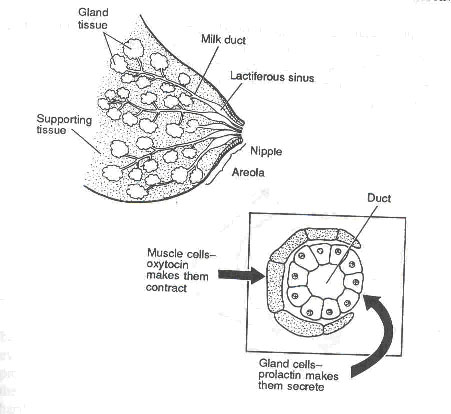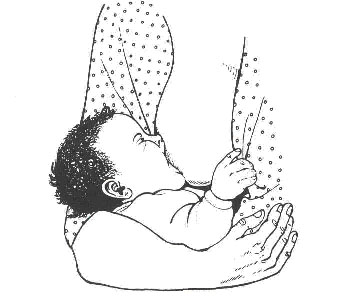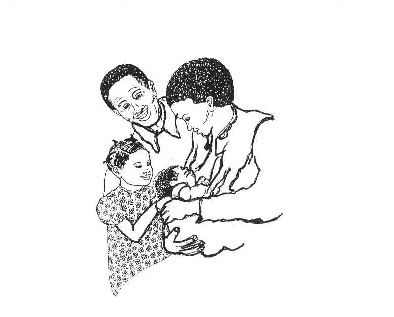Breastfeeding
Breastfeeding is the process of feeding a child with milk from the mother's breast. A child can be breastfed exclusively, without the introduction of other foods or liquids, until he or she is 4 to 6 months of age. Then other foods can be added to the child's diet in addition to breast milk.
What is exclusive breastfeeding? Exclusive breastfeeding is when a baby is fed on breast milk alone without giving any other foods or liquids for the first six months of life.
Why should one encourage mothers to breastfeed their babies? One should encourage mothers to breastfeed their babies because of the multiple benefits to the child, to herself, to her family and to society.
Breast milk provides many health benefits for the baby. When babies are exclusively breastfed, these benefits are highest. Overall, there is less illness requiring health care among exclusively breastfed babies. Exclusive breastfeeding provides the best infant nutrition and growth. With continued growth other foods are added when the child is 6 months old. Now let’s talk about specific benefits:
Benefits to the child:
- Breastfeeding provides protection against infection. Breastfed babies have less diarrhea, and fewer gastrointestinal and respiratory infections.
- Breast milk is a complete balanced diet for the newborn baby.
- Breast milk alone is enough for the needs of the baby for up to six months.
- It is perfectly clean and hygienic.
- It is available whenever baby needs it. No preparation needed, such as to boil water or sterilize bottles.
- It is always at the right temperature.
- It promotes social bonds between the mother and child.
Health benefits to the mother:
- Oxytocin, a hormone that is released while breastfeeding, contracts the uterus and helps to stop bleeding after delivery. This is why it is so important that breastfeeding begins immediately after birth and continues frequently.
- Breastfeeding women are energy efficient. They can produce milk even with limited caloric intake.
- Frequent breastfeeding delays the return of menses in some women and helps to protect against another pregnancy. Thus helps in spacing children.
- There is a lower risk of breast and ovarian cancer.
Other benefits of breastfeeding:
- Postpartum depression is reduced.
- The workload of infant feeding is reduced.
- Emotional bonding results in less child abuse and neglect.
- Breastfeeding makes night feeds and travel convenient.
- There is no worry about milk getting spoiled or running out of supplies.
- There is no worry about infant formula shortages due to poor distribution, drought or crises.
Benefits to society:
Did you know that there are also breastfeeding benefits to the society?
- The cost of an adequate diet for the mother is less than the cost of feeding a baby with artificial formula.
- Mothers can use food money for other family members. There is no need to purchase breast milk substitutes or feeding equipment, and no need for extra fuel or water.
- The costs of medical consultation, medicine, laboratory tests and hospitalization are reduced because mothers and babies are healthier.
- Thus breast feeding is economical.
The anatomy of the breast:
How milk is produced:
Milk is produced as a result of the action of hormones. Immediately after delivery, hormonal changes make the breasts begin to produce milk. When the baby begins to feed, two hormones make the milk come in the right quantity and at the right time.
Two hormones control milk production: prolactin and oxytocin. The prolactin gland is situated in the anterior pituitary glands. Once a baby sucks at the breasts, the nerve endings in the nipples send messages to the pituitary gland to release prolactin into the bloodstream. The prolactin stimulates the milk glands to secrete milk. The more a baby sucks, the more milk the breasts produce. Therefore, if a mother wishes to increase her milk supply, she should have the baby suck longer and more often. She should not miss a feed to try to “save milk” because that will make her breasts produce less. Prolactin also has the important effects of suppressing the function of the ovaries. That is how breastfeeding helps to delay the return of fertility and menstruation.
The oxytocin hormone is also called the “milk ejecting” hormone. If you watch a woman breastfeeding, you sometimes see fine streams of milk flowing from the nipple. This is called milk ejection. As you know, small muscle cells around the glands of the breasts eject milk. When they contract they squeeze out the milk. Oxytocin makes these muscles contract. In fact, many women feel the squeeze in their breasts – sometimes called the “letdown reflex” – at the beginning of a feed.
Unlike the prolactin reflex, a mother’s thoughts, feelings and sensations influence the oxytocin reflex. If a mother is worried or afraid for some reason, or in pain – especially if breastfeeding is painful – or embarrassed, it can hinder milk ejection. This can result in engorged breasts. However, if she thinks lovely thoughts of her baby, is comfortable during breastfeeding or even hears her baby crying, this may help milk ejection. So to help a mother's milk ejection, we should be kind and supportive, help her not to worry, and reassure her that she can breastfeed.
How do babies suck? Babies have three reflexes to help them suck:
- The rooting reflex: This helps a baby find the nipple. You have seen that if something touches the side of a baby’s mouth, the baby opens the mouth and turns towards it.
- The sucking reflex: When something goes into the baby’s mouth, s/he sucks it.
- The swallow reflex: Once the mouth fills with milk, the baby swallows.
As you can see, the baby has reflexes to find the nipple, suck, and swallow the milk. But there is no reflex to help the baby take the nipple to the mouth. This is where the mother comes in. For a baby to suck effectively, s/he must take enough of the nipple and areola into his/her mouth. This is called “latching on” to the breast. Sometimes new mothers need to be taught how to get the baby to latch on properly.
A baby sucking in a good position
The mother should hold the baby close to her and facing her breast. The baby needs a large mouthful of breast in order to remove milk effectively. The baby suckles in a cycle of suck/swallow/breathe. The nipple, areola, and breast tissue together form a teat within the baby’s mouth. The baby’s tongue cups along the sides of the teat, and a wave of compression moves along the tongue toward the back of the mouth. The baby swallows when the back of his mouth is full of milk. Remember that poor positioning of the baby may cause breastfeeding problems such as cracked nipples, infections or breast abscesses.
Mothers should be advised to hold their baby in the correct position and to sit or lie in a comfortable position. A bad sucking position can contribute to many common problems, such as sore nipples, not enough milk, or refusal to feed.
Overcoming problems of breastfeeding: There are a few common problems that mothers can have with breastfeeding, especially in the first one or two weeks. The most frequent are a mother’s anxieties about her performance and the amount and quality of her milk. Others include flat nipples, sore nipples, and very swollen and tender breasts.
Problems when breastfeeding are many but we shall only discuss the most common ones:
1. Mother’s anxieties (Too little milk or that it is of poor quality): The mother should be taught to pull out the nipples and gently press out a few drops of fluid. This can build up her confidence in her ability to breastfeed successfully.
2. Flat nipples: Some women have short, flat nipples. Flat nipples are most common in women who are having their first baby. If a nipple is not protractile, the baby will have difficulty in feeding.
It is very important to examine the breasts of every pregnant woman. Teach her to squeeze her nipples and pull them gently. She should do this for several minutes every day. Her nipples will grow longer. After the baby is born, the nipples can still be stretched further. The mother should squeeze the areola before putting the nipple in baby's mouth.
3. Swollen (engorged) breasts:
Sometimes a mother’s breasts produce more milk than her baby needs. This is common in the first week after the baby is born. Sometimes the baby is too weak to suck all the milk, and sometimes it is just more than the baby needs to drink.
If the breast is not emptied normally it becomes painful and swollen with milk. The skin is tight and the baby cannot put the whole areola into his/her mouth to suck. Sucking may be very painful to the mother. Mothers she can prevent and treat engorged breasts by emptying them regularly.
A husband can encourage his wife to breastfeed their baby.
Frequent breastfeeding relieves the pain. Mothers should express some milk when their breasts feel painfully full. Placing a cold cloth on the breast just after milk has been removed can help relieve oedema. If an engorged breast is not emptied, the amount of milk produced will decrease quickly.
An empty breast should be soft without any lumps. A blocked milk duct in the breast can sometimes cause a tender lump in the first week of breastfeeding. Apply a warm cloth to the areola area just before a feed to get milk started. Empty the breast and then gently press to empty the lump. This will prevent serious problems later.
4. Sore nipples: Nipples are very sensitive. If the skin is very soft and the baby sucks very hard, soreness develops. Sometimes the soreness develops into a crack that is very painful. Infection can get into the breast through a crack in the skin.
To prevent sore nipples, the mother can keep the skin soft by rubbing the areola and nipples with some oil. She should not let the baby suck for too long at first. Tell the mother to empty the breasts by expressing them if the baby does not suckle them empty. Let the nipples dry in the air after feeds.
WEANING:
Weaning is the process by which an infant gradually becomes accustomed to an adult diet. The child's diet changes from breast milk alone to a diet based on regular family meals.
Mothers should start weaning their babies at 4-6 months of age. This is because at this stage the breast milk is relatively deficient in iron and an infant’s store of iron is sufficient only until about 6 months of age. From 6 months onwards, the infant may need extra food to provide extra energy, protein, iron, and vitamins for his/her growth.
What foods should be given? It is very important for you to find out which foods are grown locally in your area and which foods are available in shops and markets. Find out some information about the feeding of young children in your community.
Remember that feeding practices are part of the customs and traditions in any community. Religious beliefs also influence feeding practices. Feeding practices may also vary among different social groups.


